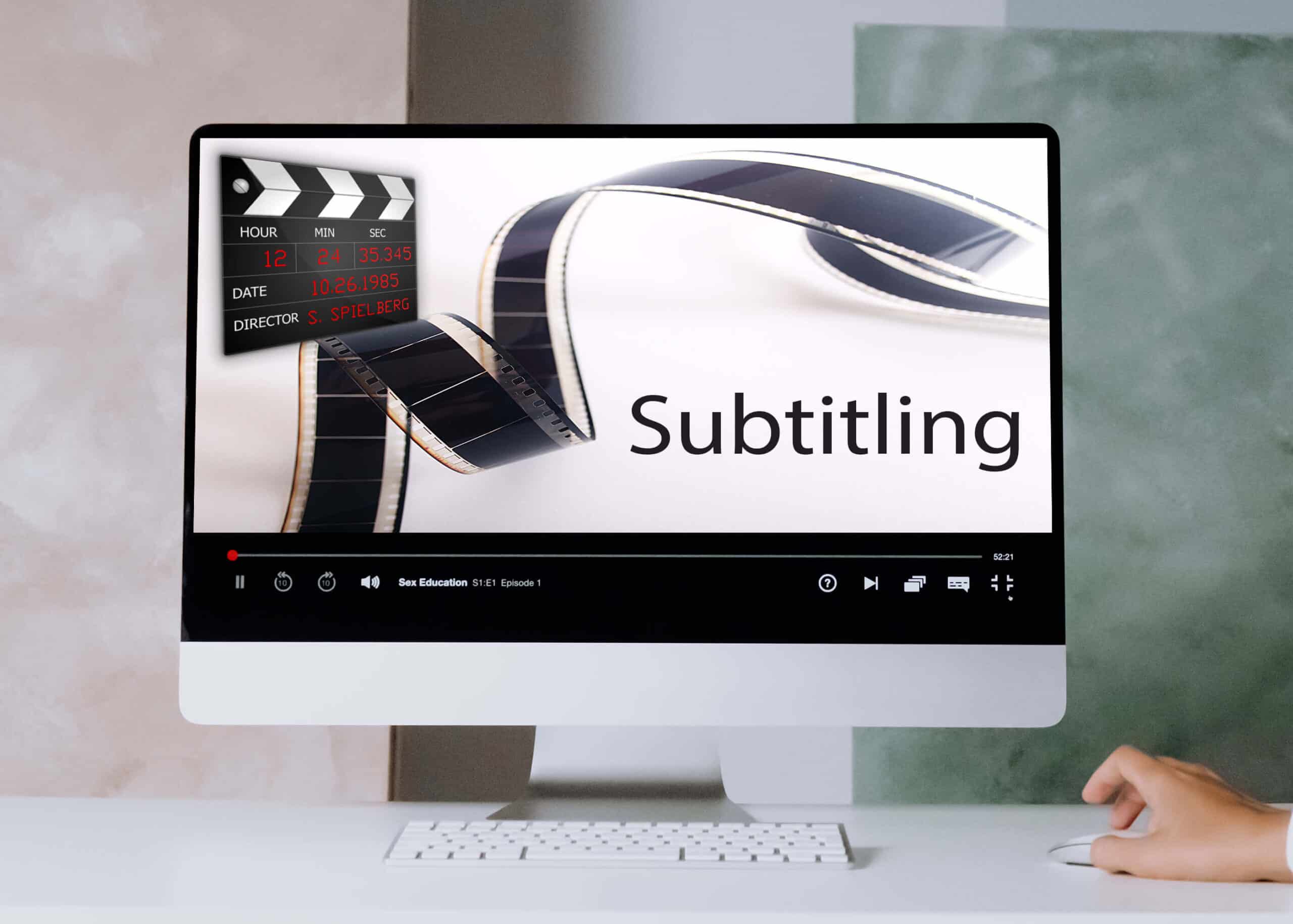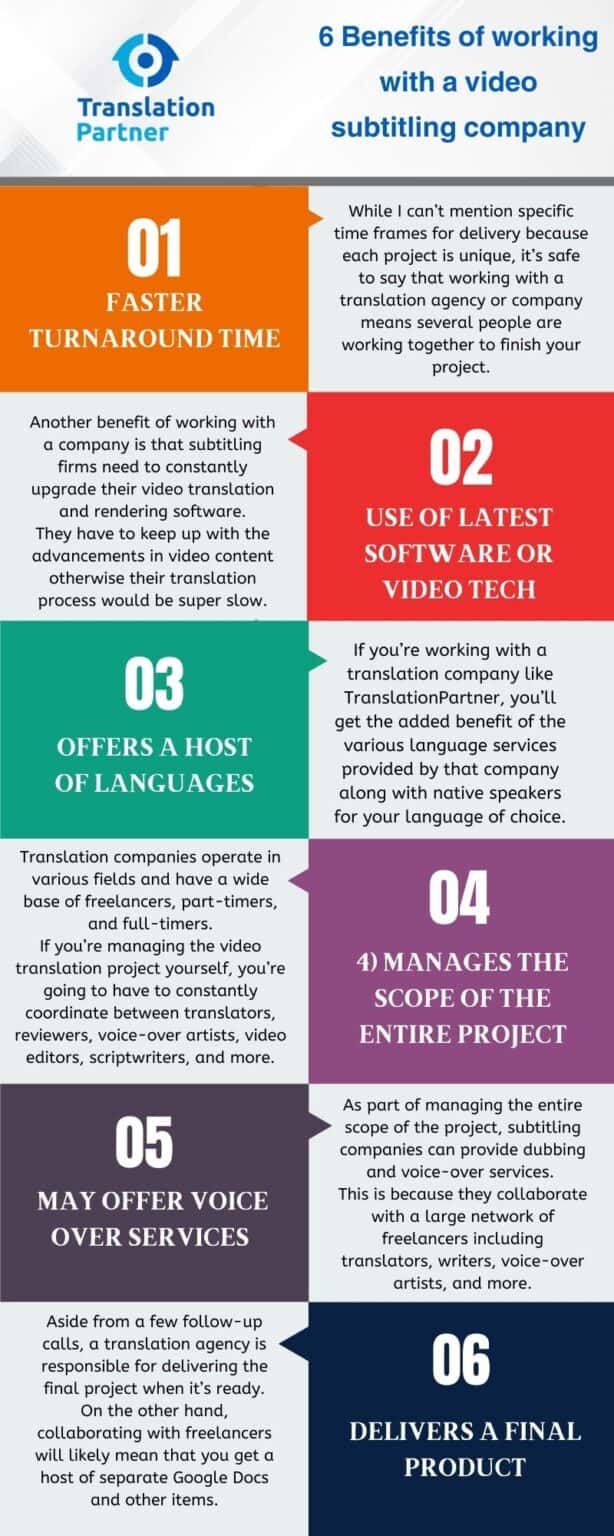6 Benefits of Working with a Video Subtitling Company

If you’re a fan of watching foreign movies or series, then you’ve probably noticed the translated text that appears at the bottom of the screen when people start talking. These are subtitles and there is an art when it comes to creating and translating these subtitles.
Subtitling translation isn’t new. It’s been around for decades.
But it has recently gained more attention with the rise of streaming apps such as Netflix, Amazon Prime, and others.
Have you noticed how the South Korean show Squid Game became Netflix’s most viewed series? And none of the actors speak English during the episodes.
So how did gain such massive viewership?
Through subtitling and dubbing. These two elements have become Netflix’s secret weapons of growth, reach, and expansion.
In this article, we’re going to focus on the art of subtitling translation, tackle important terms in the subtitling industry, and look at the benefits of working with a video subtitling translation company.
Subtitles vs Captions
Before we focus on the importance of subtitles, let’s first clarify a few industry terms.
For many people, that is movie viewers and even translators who don’t work in the subtitling field, subtitles and captions are the same things.
The truth is entirely different. They are neither the same nor can they be used interchangeably.
Subtitles are translations of dialogue.
So the next time you watch a foreign movie and see a translation of what the characters or actors are saying, remember those are subtitles.
Captions, on the other hand, relate to non-speech elements like sound effects. You’ll see this often with Netflix, which combines subtitles and captions.
Similarly, if you’re watching an English movie – let’s say an Australian movie – and reading the English subtitles, you’ll see these captions.
Examples of captioning in movies and series include “sighs” “hums” “screech” “knocking” …etc.
They are indicators of sounds the actors may make or cause but do not include speech.
Subtitling vs Dubbing
Another element that’s often mixed up with subtitling is dubbing.
Dubbing is the process of getting actors to read a translated script for a movie, TV show or series, or any type of video.
Unlike subtitling, dubbing comes after the text or speech has been translated. It’s vocalized not written.
Let’s take the Squid Game example again. If you view it on Netflix, you’ll find the option to watch the series with the actors speaking in English.
Are they really speaking English? No. They’ve brought in other actors, presented them with a translated script of the series, and had them prepare the voice-over.
This voice-over is called dubbing.
When do you need subtitles?
Now that we’ve clarified the top subtitling and translation-related terms out there, let’s see when a company would need subtitling translation.
Any video format can get subtitles. Here are the top types of video content that can deliver additional value when paired with subtitles:
Translating online courses as well as educational YouTube videos are great options for reaching a wider audience through subtitling translation and/or dubbing.
We’ve already mentioned how companies like Netflix are making major use of subtitling to grow their footprint.
As of April 2021, Netflix has invested heavily in localization and subtitling, bringing its total number of languages to 27 languages.
Netflix’s investments in subtitling translation have helped it grow its customer base by as much as 50% in two years. (Slator.com)
How often do you listen to foreign songs? Probably a lot, especially with many of them making the top charts and getting streamed on social media and radio channels.
It’s quite common for people to look up the translation of a song they like. Although many have been surprised by the lyrics of a song after translation!
Global brands would often provide subtitles to their international commercials, especially those featuring renowned actors, actresses, or football players.
The same applies to advertisements and commercials that address social responsibility or national problems.
Last but certainly not least are video games. These often require a combination of subtitling translation and dubbing efforts.
Companies that seek to translate their video games are often told that among the video game best practices require localization rather than translation.
The reason behind this is that video games, like movies, often involve a cultural aspect.
Benefits of working with a video subtitling company
Whether you’re looking to translate or localize video content, it’s important to know the aspects involved in this process.
Unlike document translation or even website translation, the process of translating video content comes with requirements and involves many angles.
This, of course, is clearer in longer videos such as movies, series, webinars, and long educational videos.
That’s why working with a video subtitling company or video translation company is a good option to reduce the number of stakeholders involved.
Let’s look at the six benefits of working with a subtitling company or video translation firm.

1) Faster turnaround time
Working with a company means you get more people on your project and accordingly a faster turnaround time.
While I can’t mention specific time frames for delivery because each project is unique, it’s safe to say that working with a translation agency or company means several people are working together to finish your project.
The same applies to the reviewing process.
2) Use of latest software or video tech
Another benefit of working with a company is that subtitling firms need to constantly upgrade their video translation and rendering software.
They have to keep up with the advancements in video content otherwise their translation process would be super slow.
3) Offers a host of languages
If you’re working with a translation company like TranslationPartner, you’ll get the added benefit of the various language services provided by that company along with native speakers for your language of choice.
For example, at TranslationParter we provide our services in 33 languages. This extends to our video translation and subtitling services.
4) Manages the scope of the entire project
Translation companies operate in various fields and have a wide base of freelancers, part-timers, and full-timers.
If you’re managing the video translation project yourself, you’re going to have to constantly coordinate between translators, reviewers, voice-over artists, video editors, scriptwriters, and more.
On the other hand, working for a translation agency means you get to highlight the main aspects and requirements for the project and let the agency handle everything from A to Z.
5) May offer voice over services
As part of managing the entire scope of the project, subtitling companies can provide dubbing and voice-over services.
This is because they collaborate with a large network of freelancers including translators, writers, voice-over artists, and more.
6) Delivers a final product
Aside from a few follow-up calls, a translation agency is responsible for delivering the final project when it’s ready.
On the other hand, collaborating with freelancers will likely mean that you get a host of separate Google Docs and other items. You’ll have to combine the translation and upload it to the video content and so on.
Subtitling translation rates
By now, you’re probably wondering what subtitling translation rates are. And it’s a valid question.
However, it’s worth mentioning that there are various aspects that affect the cost of translation. These include the target language, the length of the video, among other aspects.
And unlike other types of translation, subtitling translation is calculated on a per-minute basis.
The average price for subtitling work is $7 per minute. However, this rate may change with larger-sized projects.
Conclusion
Video subtitling began garnering lots of attention since the pandemic forced people to spend countless hours at home. And with the rise of video streaming apps, some pandemic habits have remained.
Now people from all over the globe can watch foreign movies, TV series, documentaries, docu-series – you name it, in their mother tongue through translated subtitles and dubbing.
But movies and series aren’t the only ones benefiting from subtitling. Online courses, educational videos, and various online creators are making the most of subtitling translation and dubbing services. This, in turn, is helping these creators – whether individuals or companies – reach larger and international markets and grow their audiences.
Got an educational video that you’d like to translate and use in your marketing efforts? Get in touch with our team at TranslationPartner.Select your target language from our portfolio of 33 languages and learn more about our video translation and subtitling services.
